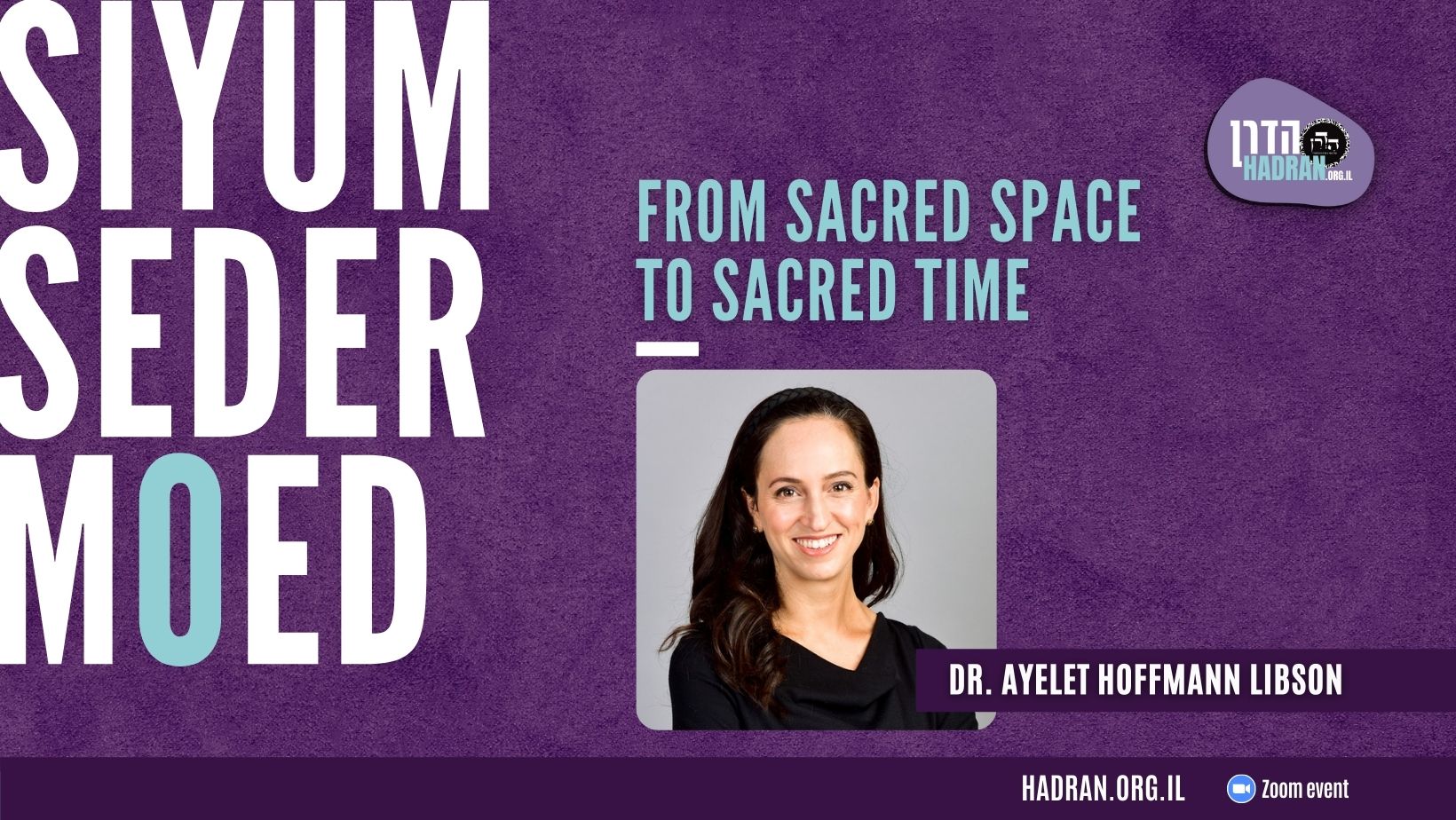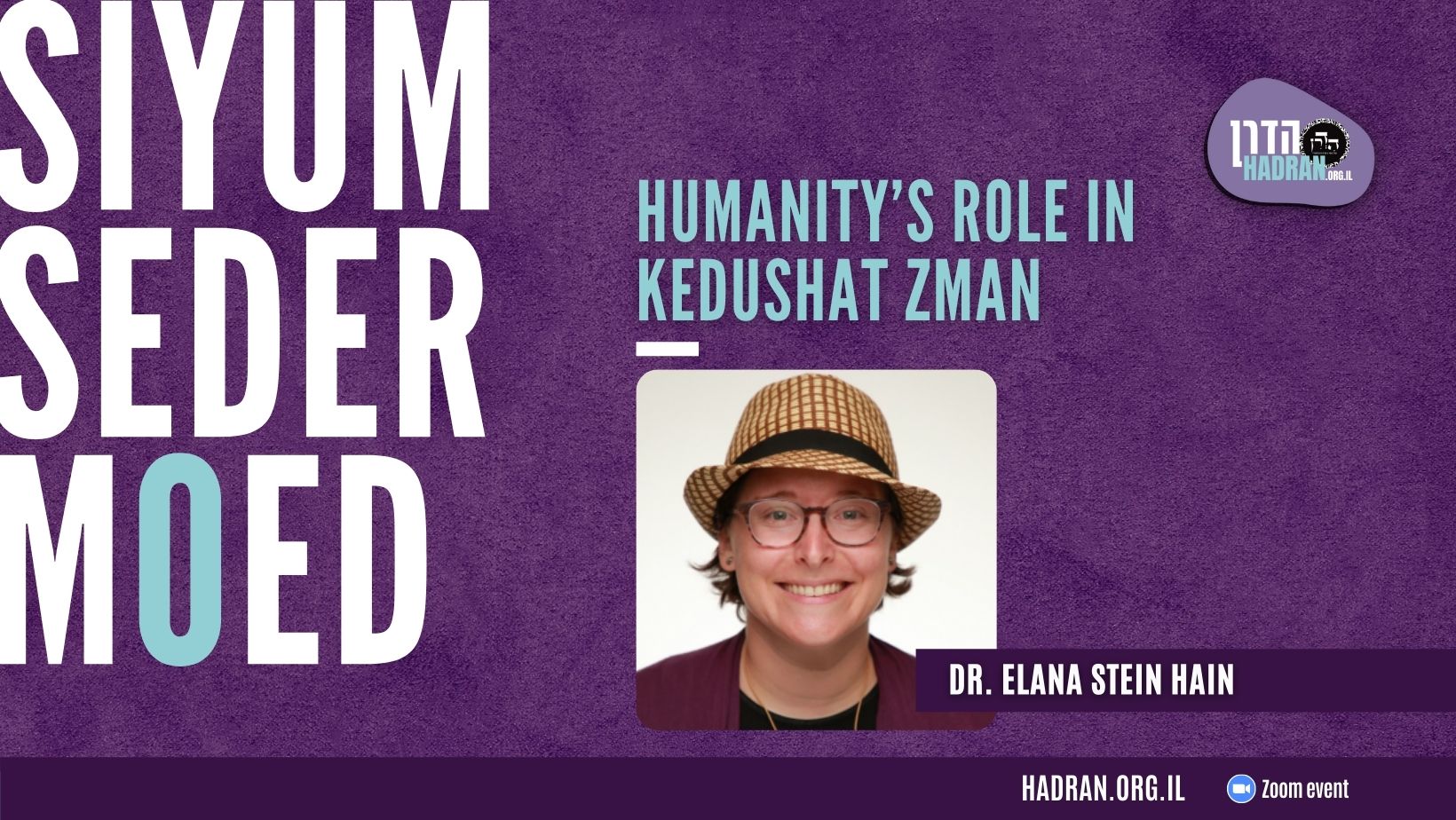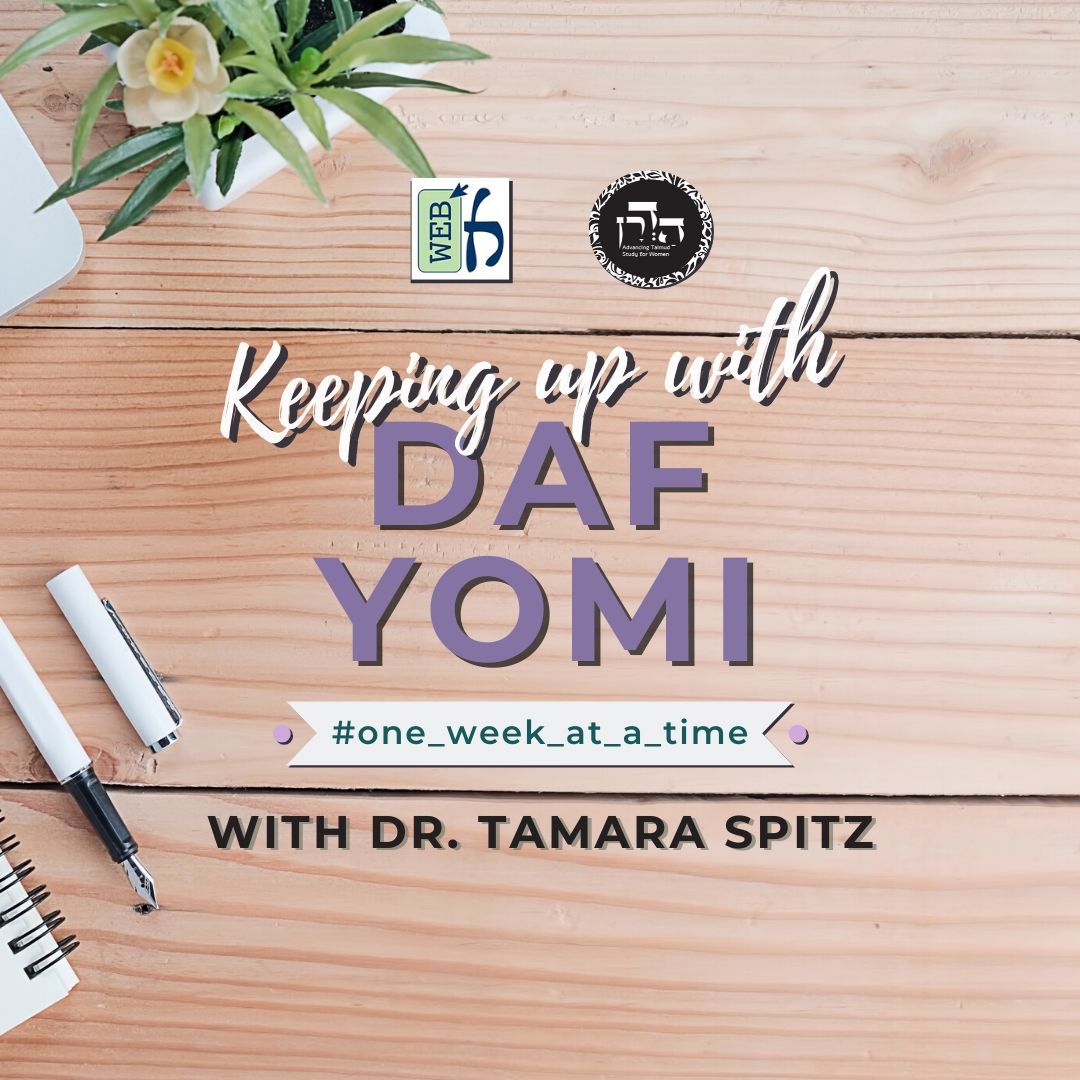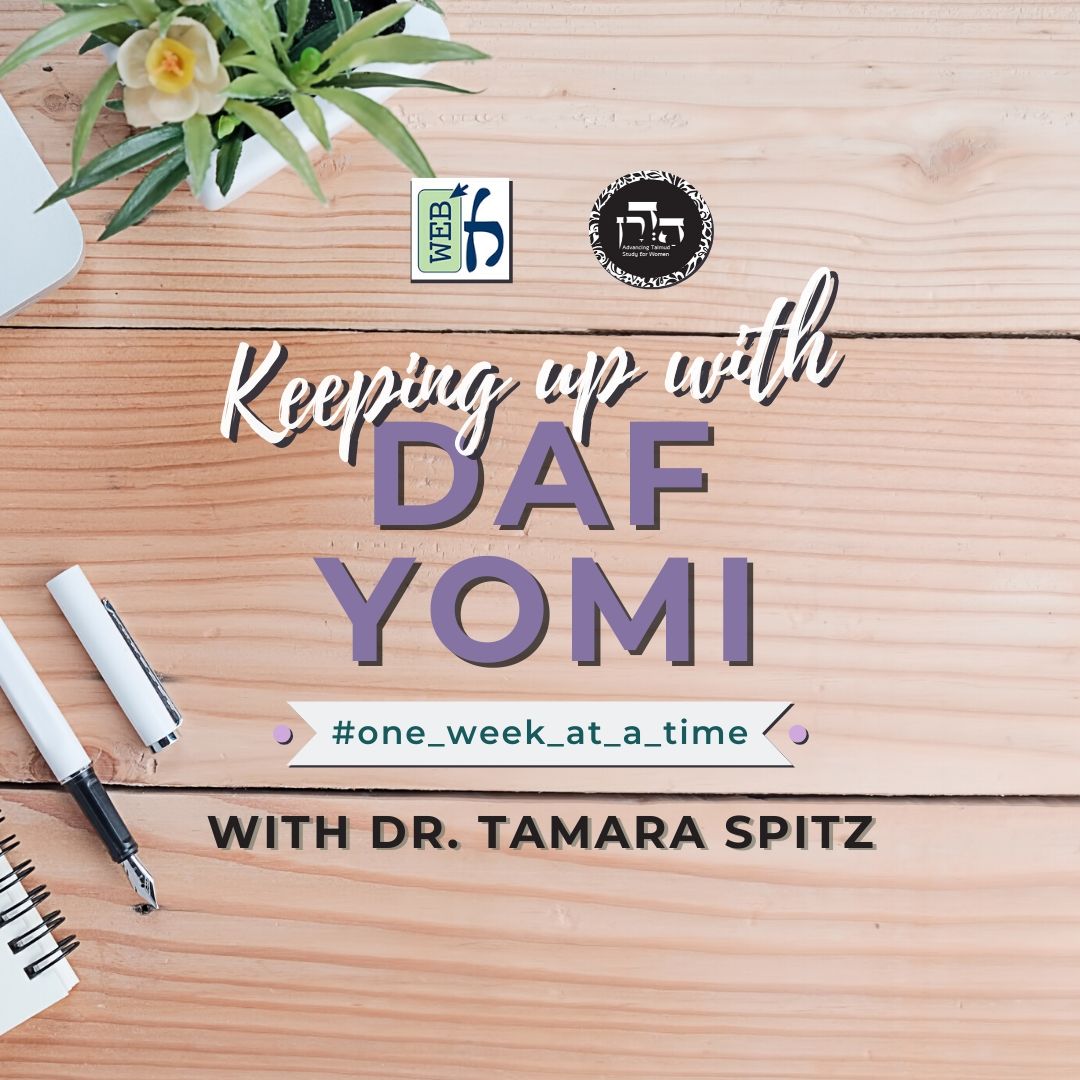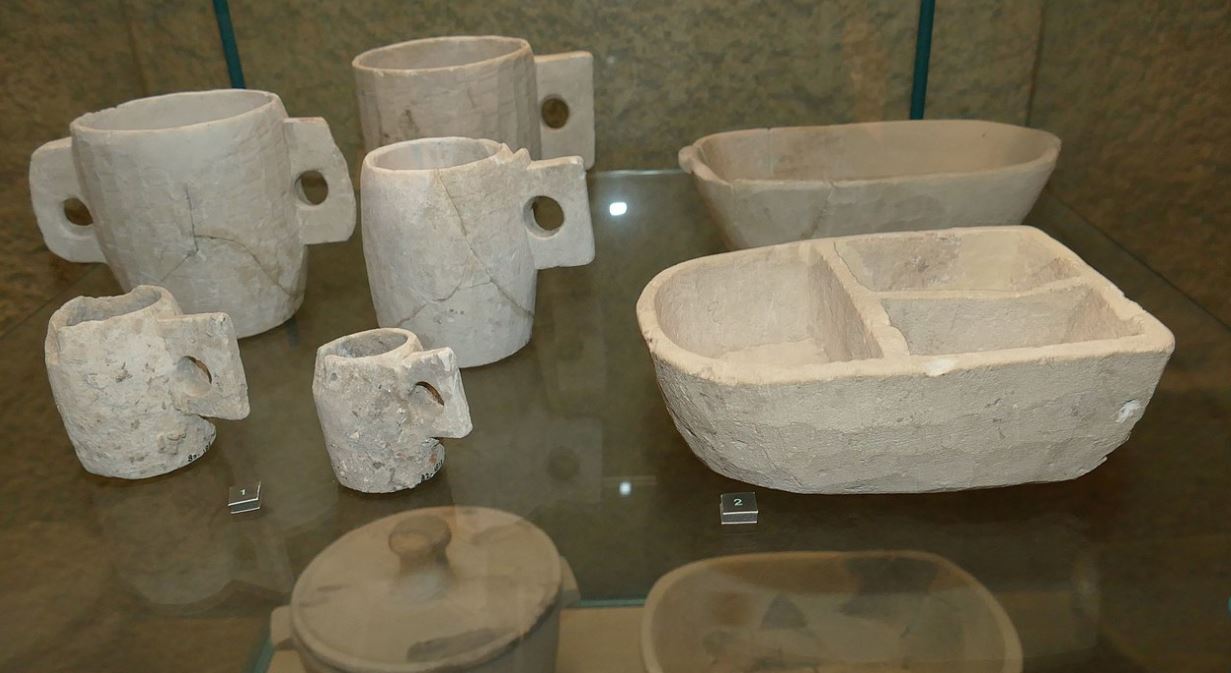Chagigah 22
וְכַחֲלָלָהּ, בִּשְׁתֵּי אֶצְבָּעוֹת חוֹזְרוֹת לִמְקוֹמָן.
and its space, which is equivalent to the width of two fingers going around in their place, i.e., a space large enough to insert two fingers and twist them around inside. If one body of water contains the requisite forty se’a, while another, adjacent body is lacking this amount, then if the opening between the two bodies of water is wider than this measurement, the two bodies are considered as one, and the smaller body is also considered an acceptable ritual bath. Since any opening smaller than this is not considered to connect two bodies of water, the water inside a bottle with a narrow mouth would be considered disconnected from the water of the ritual bath, and smaller vessels inside such a narrow-necked vessel would not be considered as having come into contact with the water of the ritual bath. The Sages therefore enacted a decree rendering prohibited the immersion of any vessel inside another vessel.
סָבַר לַהּ כְּהָא דְּאָמַר רַב נַחְמָן אָמַר רַבָּה בַּר אֲבוּהּ: אַחַת עֶשְׂרֵה מַעֲלוֹת שָׁנוּ כָּאן: שֵׁשׁ רִאשׁוֹנוֹת — בֵּין לַקּוֹדֶשׁ, בֵּין לְחוּלִּין שֶׁנַּעֲשׂוּ עַל טׇהֳרַת הַקּוֹדֶשׁ. אַחֲרוֹנוֹת — לַקּוֹדֶשׁ, אֲבָל לֹא לְחוּלִּין שֶׁנַּעֲשׂוּ עַל טׇהֳרַת הַקּוֹדֶשׁ.
The Gemara notes: Rava holds in accordance with this statement that Rav Naḥman said that Rabba bar Avuh said: They taught eleven stringencies of sacrificial food here in this mishna, rather than Rabbi Ila’s ten. The first six stringencies apply both to sacrificial food itself and to non-sacred food that was prepared according to the standards of purity of sacrificial food, whereas the last five apply only to actual sacrificial food but not to non-sacred food that was prepared according to the standards of purity of sacrificial food.
מַאי אִיכָּא בֵּין דְּרָבָא לִדְרַבִּי אִילָא?
The Gemara asks: What practical difference is there between the opinion of Rava, i.e., that the Sages rendered it prohibited to immerse one vessel inside of another because they were concerned lest one immerse needles in a vessel whose mouth is narrower than the tube of a wineskin, and the opinion of Rabbi Ila, who holds that their concern was about interposition?
אִיכָּא בֵּינַיְיהוּ סַל וְגַרְגוּתְנִי שֶׁמִּילְּאָן כֵּלִים וְהִטְבִּילָן. לְמַאן דְּאָמַר מִשּׁוּם חֲצִיצָה — אִיכָּא. לְמַאן דְּאָמַר מִשּׁוּם גְּזֵירָה שֶׁמָּא יַטְבִּיל מְחָטִין וְצִינּוֹרִיּוֹת בִּכְלִי שֶׁאֵין בְּפִיו כִּשְׁפוֹפֶרֶת הַנּוֹד — סַל וְגַרְגוּתְנִי שֶׁאֵין בְּפִיהֶן כִּשְׁפוֹפֶרֶת הַנּוֹד, לֵיכָּא.
The Gemara answers: The practical difference between them is in the case of a basket or a wicker bin [gargutni] that one has filled with smaller vessels and has immersed them all together. According to Rabbi Ila, the one who said it is prohibited to immerse one vessel inside another due to the concern of interposition, in this case as well there is such a concern, as the inner vessels might weigh down against the basket and prevent the water from touching the contact points. But according to Rava, the one who said it is prohibited due to a rabbinic decree lest one immerse needles and hooks inside a vessel whose mouth does not have the width of the tube of a wineskin, there are no such things as baskets and wicker bins whose mouth does not have the width of the tube of a wineskin, and therefore the decree would not apply to them.
רָבָא לְטַעְמֵיהּ, דְּאָמַר רָבָא: סַל וְגַרְגוּתְנִי שֶׁמִּילְּאָן כֵּלִים וְהִטְבִּילָן — טְהוֹרִין.
The Gemara notes: And Rava follows his line of reasoning, as Rava said: A basket or wicker bin that one has filled with smaller vessels and has immersed them all together, they are pure in all regards, even for sacrificial food.
וּמִקְוֶה שֶׁחֲלָקוֹ בְּסַל וְגַרְגוּתְנִי — הַטּוֹבֵל שָׁם לֹא עָלְתָה לוֹ טְבִילָה. דְּהָא אַרְעָא כּוּלַּהּ חַלְחוֹלֵי מְחַלְחֲלָא, וּבָעֵינַן דְּאִיכָּא אַרְבָּעִים סְאָה בְּמָקוֹם אֶחָד.
Rava stated a second teaching with regard to baskets and bins as well: And in the case of a ritual bath that one divided into two sections by inserting a basket or wicker bin, so that each section is left with less than the required forty se’a, if one immerses there, his immersion is ineffective for him. Despite the certainty that water seeps through the basket or bin, this is not enough to join the two incomplete sections of the ritual bath to be counted as one. We know that this is so, for the earth is entirely porous, and nevertheless we do not rely on this to allow several adjacent, small ditches full of water to add up to forty se’a, but rather require that there be forty se’a together in one place.
וְהָנֵי מִילֵּי בִּכְלִי טָהוֹר, אֲבָל בִּכְלִי טָמֵא, מִיגּוֹ דְּסָלְקָא טְבִילָה לְכוּלֵּיהּ גּוּפֵיהּ דְּמָנָא, סָלְקָא לְהוּ נָמֵי לְכֵלִים דְּאִית בֵּיהּ.
The Gemara comments: And this halakha, that small vessels such as needles cannot be immersed inside a vessel with a narrow opening, applies only if he immersed them in a pure vessel, which does not require purification on its own. But if he did so in an impure vessel, which requires purification in its own right, since the immersion is effective for the whole of the outer vessel, including its inside, it is also effective for the vessels that are inside of it. Since the water that enters the outer vessel is considered attached to the rest of the ritual bath for purposes of purification of the outer vessel, so is it considered attached with regard to the purification of the inner vessels.
דִּתְנַן: כֵּלִים שֶׁמִּילְּאָן כֵּלִים וְהִטְבִּילָן — הֲרֵי אֵלּוּ טְהוֹרִין. וְאִם לֹא טָבַל, מַיִם הַמְעוֹרָבִים — עַד שֶׁיִּהְיוּ מְעוֹרָבִין כִּשְׁפוֹפֶרֶת הַנּוֹד. מַאי קָאָמַר וְאִם לֹא טָבַל? הָכִי קָאָמַר: וְאִם אֵינוֹ צָרִיךְ לְהַטְבִּילוֹ, וּמַיִם הַמְעוֹרָבִין עַד שֶׁיְּהוּ מְעוֹרָבִין כִּשְׁפוֹפֶרֶת הַנּוֹד.
We know this, as we learned in a mishna (Mikvaot 6:2): With regard to vessels that one filled with other vessels and immersed them all together, they are pure, regardless of the width of the opening of the outer vessel. And if he did not immerse, the joining of waters is not effective until they are joined like the width of the tube of a wineskin. This second sentence of the mishna is unclear, and the Gemara seeks to clarify it. What is the mishna saying here when it says: And if he did not immerse? The Gemara explains. This is what the mishna is saying: And if he has no need to immerse the outer vessel, as it was already pure, and similarly in a case of two bodies of water that are joined together by means of a hole, it is not valid until the water is joined through a space as wide as the tube of a wineskin.
וְהָא דְּרָבָא וּדְרַבִּי אִילָא תַּנָּאֵי הִיא. דְּתַנְיָא: סַל וְגַרְגוּתְנִי שֶׁמִּילְּאָן כֵּלִים וְהִטְבִּילָן בֵּין לַקּוֹדֶשׁ בֵּין לַתְּרוּמָה, טְהוֹרִין. אַבָּא שָׁאוּל אוֹמֵר: לַתְּרוּמָה אֲבָל לֹא לַקּוֹדֶשׁ.
§ The Gemara notes: And this dispute between Rava and Rabbi Ila is also a dispute between tanna’im. As it is taught in a baraita: With regard to a basket or a wicker bin that one filled with vessels and then immersed them, whether for purposes of sacrificial food or for purposes of teruma, they are pure. This is identical to Rava’s opinion. Abba Shaul says: They are pure for purposes of teruma but not for purposes of sacrificial food. This is identical to Rabbi Ila’s opinion.
אִי הָכִי, תְּרוּמָה נָמֵי! לְמַאן קָאָמְרִינַן — חֲבֵרִים, חֲבֵרִים מִידָּע יָדְעִי.
The Gemara asks: If so, in light of these two reasons we have given for concern with regard to immersing vessels inside other vessels, this should not be permitted for teruma either. The Gemara responds: For whom do we say the principle that one vessel may not be immersed inside another? For ḥaverim, individuals devoted to the meticulous observance of mitzvot, especially halakhot of ritual purity. Others do not carefully follow these halakhot in any event. And ḥaverim know such things well, that water is considered detached from the ritual bath if it is separated by a narrow opening, and that if one vessel is weighing down on another, preventing the water from reaching that spot, the top vessel must be lifted to allow the water to touch all parts of the vessel. Therefore, there is no need to apply these concerns and stringencies to the case of teruma.
אִי הָכִי, קוֹדֶשׁ נָמֵי! חָזֵי לֵיהּ עַם הָאָרֶץ וְאָזֵיל מַטְבִּיל.
The Gemara counters with another question. If so, we should say the same thing in the case of sacrificial food too, i.e., that all these halakhot are for ḥaverim, who meticulously follow ritual purity for sacrificial food and inquire about such halakhot. Why, then, did the Sages apply these concerns and stringencies to the case of sacrificial food? The Gemara responds: With regard to sacrificial food they were concerned that a common person [am ha’aretz], who is not meticulous about ritual purity, may see the ḥaver immersing small vessels inside of large vessels, and will then go and immerse vessels of his own in this manner. But he will not take the same precautions as the ḥaver would, ensuring that the outer vessel has a wide opening and that the vessels on top do not weigh down on the lower ones.
תְּרוּמָה נָמֵי, חָזֵי לֵיהּ עַם הָאָרֶץ וְאָזֵיל מַטְבִּיל! לָא מְקַבְּלִינַן מִינַּיְיהוּ.
The Gemara objects: But the same concern could be raised with regard to teruma as well. It is possible that an am ha’aretz may see the ḥaver immerse vessels for teruma in this manner, and he will then go and immerse his vessels this way, without taking the precautions that the ḥaver would take. The Gemara answers: We do not accept teruma from amei ha’aretz, as they are not trustworthy with regard to the halakhot of ritual purity, and therefore it does not matter if the vessels he uses for teruma are not immersed properly. Therefore, the Sages were not concerned that the am ha’aretz may come to a misunderstanding when observing a ḥaver immersing vessels within vessels.
קוֹדֶשׁ נָמֵי, לָא נְקַבֵּיל מִינַּיְיהוּ! הָוְיָא לֵיהּ אֵיבָה.
The Gemara continues its line of questioning. If so, we should likewise not accept sacrificial food from amei ha’aretz, since they are not sufficiently meticulous with ritual purity, and we should therefore not care if they immerse their vessels improperly. The Gemara responds: The am ha’aretz will have feelings of antagonism if sacrificial food is not accepted from him, and this would lead to internal discord and conflict within Israel.
תְּרוּמָה נָמֵי, הָוְיָא לֵיהּ אֵיבָה! לָא אִיכְפַּת לֵיהּ, דְּאָזֵיל יָהֵיב לֵיהּ לְכֹהֵן עַם הָאָרֶץ חַבְרֵיהּ.
The Gemara asks: If so, in the case of teruma he will also have feelings of antagonism if teruma is not accepted from him. Why were the Sages concerned about this factor only with regard to sacrificial food and not teruma? The Gemara replies: An am ha’aretz does not care if his teruma is not accepted by ḥaverim, as he can always go and give his teruma to an am ha’aretz priest who is his friend and who will accept it from him. In the case of sacrificial food, however, there is only one Temple, and care must be taken not to make the amei ha’aretz feel they are being rejected.
וּמַאן תַּנָּא דְּחָיֵישׁ לְאֵיבָה — רַבִּי יוֹסֵי הִיא. דְּתַנְיָא, אָמַר רַבִּי יוֹסֵי: מִפְּנֵי מָה הַכֹּל נֶאֱמָנִין עַל טׇהֳרַת יַיִן וָשֶׁמֶן כׇּל יְמוֹת הַשָּׁנָה — כְּדֵי שֶׁלֹּא יְהֵא כׇּל אֶחָד וְאֶחָד הוֹלֵךְ וּבוֹנֶה בָּמָה לְעַצְמוֹ, וְשׂוֹרֵף פָּרָה אֲדוּמָּה לְעַצְמוֹ.
The Gemara notes that this sensitivity of not causing offense to the am ha’aretz is expressed elsewhere as well: And who is the tanna that is concerned for such antagonism of amei ha’aretz? It is Rabbi Yosei, as it is taught in a baraita: Rabbi Yosei said: For what reason are all people, i.e., even amei ha’aretz, trusted with regard to the purity of their wine and oil that they bring to the Temple for sacrificial purposes throughout the year? Why is the status of these items not investigated to determine that they were prepared with the necessary regard for ritual purity? In order to avoid schisms among the people, so that each and every individual should not go off and build a private altar for himself and burn a red heifer for himself. Were the Sages to reject sacrificial wine and oil from amei ha’aretz, they would become alienated and go off and create schisms, going so far as to build their own separate temples and bring their own private offerings.
אָמַר רַב פָּפָּא: כְּמַאן מְקַבְּלִינַן הָאִידָּנָא סָהֲדוּתָא מֵעַם הָאָרֶץ — כְּמַאן כְּרַבִּי יוֹסֵי.
Rav Pappa said: In accordance with whose opinion do we accept testimony nowadays from an am ha’aretz, despite the concern of some Sages that their carelessness with regard to observance of halakha might also lead to personal untrustworthiness? In accordance with whom is this done? In accordance with the opinion of Rabbi Yosei.
וְנֵיחוּשׁ לִשְׁאֵלָה.
§ We have established that the reason for leniency with regard to immersing one vessel inside another for teruma is based on the fact that we do not care if the vessels amei ha’aretz use for teruma are improperly purified, since we do not accept teruma from them in any event. The Gemara asks: But let us be concerned about borrowing vessels from them. Although ḥaverim do not accept teruma from an am ha’aretz, they do sometimes borrow their vessels and use them for teruma. It should therefore be a matter of concern for us if those vessels are not properly purified.
דִּתְנַן: כְּלִי חֶרֶס מַצִּיל עַל הַכֹּל, דִּבְרֵי בֵּית הִלֵּל. בֵּית שַׁמַּאי אוֹמְרִים: אֵינוֹ מַצִּיל אֶלָּא עַל אוֹכָלִים וְעַל הַמַּשְׁקִים וְעַל כְּלֵי חֶרֶס.
The Gemara proves that it is acceptable to borrow vessels from an am ha’aretz: As we learned in a mishna (Eduyyot 1:14): An earthenware vessel of an am ha’aretz shields all kinds of items from the ritual impurity imparted by a corpse. There are two applications of this fact: If there are objects or foods inside a tightly sealed earthenware vessel located inside a room containing a corpse, the vessel prevents the impurity from reaching the items inside it. Also, if there is a corpse in the first floor of a house and food or vessels are located in a second story of the same building, with an opening such as a skylight in the floor between the two stories, an earthenware vessel plugging up the opening will prevent the ritual impurity from spreading to the second story. This is the statement of Beit Hillel. Beit Shammai say: It shields only food, drink, and earthenware vessels, but not utensils of metal, wood, cloth, etc.
אָמְרוּ לָהֶם בֵּית הִלֵּל לְבֵית שַׁמַּאי: מִפְּנֵי מָה? אָמְרוּ בֵּית שַׁמַּאי: מִפְּנֵי שֶׁהוּא טָמֵא עַל גַּבֵּי עַם הָאָרֶץ, וְאֵין כְּלִי טָמֵא חוֹצֵץ. אָמְרוּ לָהֶם בֵּית הִלֵּל: וַהֲלֹא טִיהַרְתֶּם אוֹכָלִין וּמַשְׁקִין שֶׁבְּתוֹכוֹ! אָמְרוּ לָהֶם בֵּית שַׁמַּאי: כְּשֶׁטִּיהַרְנוּ אוֹכָלִין וּמַשְׁקִין שֶׁבְּתוֹכוֹ —
The mishna continues: Beit Hillel said to Beit Shammai: For what reason do you make this distinction? It is clear that a closed, pure earthenware vessel serves as a barrier, blocking the spread of impurity in a room with a corpse (see Numbers 19:15). Beit Shammai said to them: Because the earthenware vessel itself is impure on account of its contact with an am ha’aretz. The Sages decreed that anything touched by an am ha’aretz is impure, since such people are not meticulous or sufficiently knowledgeable about the halakhot of purity; therefore his vessels are considered impure. And the principle is that an impure vessel does not serve as a barrier from impurity. Beit Hillel said to them: But didn’t you declare the food and drink inside the earthenware vessel to be pure? If the vessel of an am ha’aretz cannot serve as a barrier, why do you say that some items inside it are pure? Beit Shammai said to them: When we declared the food and drink inside it to be pure,
לְעַצְמוֹ טִהַרְנוּ.
we declared them pure for the am ha’aretz himself, not for ḥaverim, since ḥaverim in any event do not consider anything touched by an am ha’aretz to be pure. A ḥaver would therefore never relate to the food of an am ha’aretz as pure, and he would not use the earthenware vessels of an am ha’aretz for preparation of pure food, since an earthenware vessel cannot be purified through immersion. However, he might borrow a metal vessel, for instance, and purify it through immersion before using it for pure food.
אֲבָל נְטַהֵר אֶת הַכְּלִי, שֶׁטׇּהֳרָתוֹ לְךָ וָלוֹ?
But how can we purify a vessel of metal and other materials, whose purity would be relevant both for you and for him? A ḥaver may one day borrow a metal vessel from the am ha’aretz, and not realize that it was once inside an earthenware vessel in the same room as a corpse and as a result requires extensive purification from corpse contamination through the ashes of the red heifer, rather than mere immersion. Therefore, the am ha’aretz is informed that his vessels of metal and other materials have contracted impurity from the corpse, and must undergo the extensive purification process, and after this is done these vessels will now be fit for use of the ḥaver after mere immersion.
תַּנְיָא, אָמַר רַבִּי יְהוֹשֻׁעַ: בּוֹשַׁנִי מִדִּבְרֵיכֶם, בֵּית שַׁמַּאי! אֶפְשָׁר אִשָּׁה לָשָׁה בַּעֲרֵיבָה — אִשָּׁה וַעֲרֵיבָה טְמֵאִין שִׁבְעָה, וּבָצֵק טָהוֹר? לוֹגִין מָלֵא מַשְׁקִין — לוֹגִין טָמֵא טוּמְאַת שִׁבְעָה, וּמַשְׁקִין טְהוֹרִין?!
It is taught in a baraita with regard to this debate between Beit Shammai and Beit Hillel: Rabbi Yehoshua said: I am ashamed of your words, Beit Shammai, for they are illogical. Is it possible that there should be a corpse on the first floor, with an earthenware vessel blocking the opening to the second story, and a woman is standing upstairs kneading dough in a metal bowl, and the woman and the bowl are impure for seven days owing to the impurity of the corpse, while the dough inside the trough is pure? For that would be the result according to Beit Shammai, who distinguishes between food and earthenware vessels on the one hand and metal vessels on the other. Similarly: Is it possible that there is a metal pitcher [login] full of liquid in the second story, and the pitcher should be impure with impurity of seven days, while the liquids remain pure?
נִטְפַּל לוֹ תַּלְמִיד אֶחָד מִתַּלְמִידֵי בֵּית שַׁמַּאי, אָמַר לוֹ: אוֹמַר לְךָ טַעְמָן שֶׁל בֵּית שַׁמַּאי. אָמַר לוֹ: אֱמוֹר. אָמַר לוֹ: כְּלִי טָמֵא — חוֹצֵץ אוֹ אֵינוֹ חוֹצֵץ? אָמַר לוֹ: אֵינוֹ חוֹצֵץ. כְּלִי שֶׁל עַם הָאָרֶץ — טָמֵא אוֹ טָהוֹר? אָמַר לוֹ: טָמֵא. וְאִם אַתָּה אוֹמֵר לוֹ ״טָמֵא״, כְּלוּם מַשְׁגִּיחַ עָלֶיךָ? וְלֹא עוֹד, אֶלָּא שֶׁאִם אַתָּה אוֹמֵר לוֹ ״טָמֵא״, אוֹמֵר לְךָ: ״שֶׁלִּי טָהוֹר וְשֶׁלְּךָ טָמֵא״.
After Rabbi Yehoshua posed this question, one student from among the students of Beit Shammai approached him and said to him: I will tell you Beit Shammai’s reasoning. He said to him: Speak. He said to him: Does an impure vessel serve as a barrier to corpse contamination or does it not serve as a barrier? Rabbi Yehoshua said to him: It does not serve as a barrier. The student asked further: And is a vessel of an am ha’aretz pure or impure? He said to him: Impure. The student responded: And if you tell him that his vessel is impure, will he pay attention to you at all? Clearly he will not. What is more, if you say to him that it is impure, he will say to you: On the contrary, my vessel is pure and yours is impure.
וְזֶהוּ טַעְמָן שֶׁל בֵּית שַׁמַּאי.
And that is Beit Shammai’s reasoning: Food, drink, and earthenware vessels inside a sealed earthenware vessel remain pure, as, since they belong to an am ha’aretz, a ḥaver will not eat the food or borrow the earthenware vessel. Vessels of metal or similar materials may one day be borrowed by a ḥaver, however, and therefore Beit Shammai declared these to be impure.
מִיָּד הָלַךְ רַבִּי יְהוֹשֻׁעַ וְנִשְׁתַּטַּח עַל קִבְרֵי בֵּית שַׁמַּאי, אָמַר: נַעֲנֵיתִי לָכֶם עַצְמוֹת בֵּית שַׁמַּאי! וּמָה סְתוּמוֹת שֶׁלָּכֶם כָּךְ, מְפוֹרָשׁוֹת — עַל אַחַת כַּמָּה וְכַמָּה. אָמְרוּ: כׇּל יָמָיו הוּשְׁחֲרוּ שִׁינָּיו מִפְּנֵי תַּעֲנִיּוֹתָיו.
Once he heard the logic behind Beit Shammai’s opinion, Rabbi Yehoshua immediately went and prostrated himself on the graves of Beit Shammai, i.e., the students and proponents of Shammai, and said: I humble myself before you, bones of Beit Shammai. If such clarity and wisdom is found in your rulings that you stated and left unexplained, all the more so must this be the case in your rulings when they were stated and explained. People said of Rabbi Yehoshua: Throughout his days his teeth darkened because of all his fasts that he undertook to atone for having spoken inappropriately of Beit Shammai.
קָתָנֵי מִיהַת ״לְךָ וָלוֹ״, אַלְמָא שָׁאֲלִינַן מִינַּיְיהוּ! כִּי שָׁיְילִינַן מִינַּיְיהוּ מַטְבְּלִינַן לְהוּ.
The Gemara returns to its main point. In any event, this mishna teaches that the status of the vessels of an am ha’aretz is relevant both for you and for him. Apparently, then, we ḥaverim may borrow vessels from amei ha’aretz. The question therefore arises: Why are the Sages not concerned that amei ha’aretz may immerse vessels inside of other vessels in an inappropriate way, so that they will remain unpurified when borrowed by a ḥaver? The Gemara answers: For when we ḥaverim borrow vessels from them we immerse them before using them. It is therefore inconsequential to us if their vessels were not immersed properly beforehand.
אִי הָכִי, נַיהְדְּרוּ לְהוּ בֵּית הִלֵּל לְבֵית שַׁמַּאי: כִּי שָׁאֲלִינַן מִינַּיְיהוּ מַטְבְּלִינַן לְהוּ! טְמֵא מֵת בָּעֵי הַזָּאָה שְׁלִישִׁי וּשְׁבִיעִי, וּמָנָא לְשִׁבְעָה יוֹמֵי לָא מוֹשְׁלִי אִינָשֵׁי.
The Gemara asks: If so, let Beit Hillel respond to Beit Shammai. They can respond as follows: When we borrow vessels from them we immerse them, and that is why we rule that vessels of metal or similar materials are pure. The Gemara explains: That dispute is referring to the impurity of a corpse. And that which becomes impure by proximity to a corpse requires sprinkling of the red heifer’s ashes on the third and seventh days of its purification, and people do not generally lend vessels for seven days. The solution the ḥaver implements of immersing vessels that he borrows from an am ha’aretz is effective only for other impurities, but not for the impurity imparted by a corpse.
וְאַטְּבִילָה לָא מְהֵימְנִי? וְהָתַנְיָא: נֶאֱמָנִין עַמֵּי הָאָרֶץ עַל טׇהֳרַת טְבִילַת טְמֵא מֵת!
The Gemara poses a question with regard to the halakha that a ḥaver must immerse vessels that he borrows from an am ha’aretz: But is it so that amei ha’aretz are not trusted with regard to immersion? Isn’t it taught in a baraita: Amei ha’aretz are trusted with regard to the purification process of immersion of that which has become impure by contact with a corpse? In addition to being sprinkled with purification water on the third and seventh days, a person or article that has been in contact with a corpse must also undergo immersion on the seventh day. An am ha’aretz is believed when he says that he has performed this immersion.
אָמַר אַבָּיֵי, לָא קַשְׁיָא: הָא בְּגוּפוֹ, הָא בְּכֵלָיו. רָבָא אָמַר: אִידֵּי וְאִידֵּי בְּכֵלָיו, וְלָא קַשְׁיָא: הָא דְּאָמַר ״מֵעוֹלָם לֹא הִטְבַּלְתִּי כְּלִי בְּתוֹךְ כְּלִי״, וְהָא דְּאָמַר ״הִטְבַּלְתִּי, אֲבָל לֹא הִטְבַּלְתִּי בִּכְלִי שֶׁאֵין בְּפִיו כִּשְׁפוֹפֶרֶת הַנּוֹד״.
The Gemara presents two answers for this question. Abaye said one answer: This is not difficult. This baraita, which teaches that an am ha’aretz is trusted, is referring to the immersion of his body, whereas this teaching of the Gemara that amei ha’aretz are not trusted concerning immersion deals with his vessels. Rava said a different answer: Both this and that, both the baraita and the Gemara’s teaching, refer to the vessels of an am ha’aretz, and it is nevertheless not difficult. This baraita, which teaches that an am ha’aretz is trusted, is referring to an am ha’aretz who said: I never immersed one vessel inside another, which is a statement that we accept. And this teaching of the Gemara that amei ha’aretz are not trusted deals with one who said: I have immersed vessels inside of other vessels, but I did not immerse with a vessel whose mouth does not have the width of the tube of a wineskin. It is with regard to such details that an am ha’aretz cannot be trusted.
וְהָתַנְיָא: נֶאֱמָן עַם הָאָרֶץ לוֹמַר פֵּירוֹת לֹא הוּכְשְׁרוּ, אֲבָל אֵינוֹ נֶאֱמָן לוֹמַר פֵּירוֹת הוּכְשְׁרוּ אֲבָל לֹא נִטְמְאוּ.
And so it was taught in a baraita to this effect: An am ha’aretz is trusted to say that produce has not been made susceptible to impurity, i.e., that it has never come into contact with water, but he is not trusted to say that the produce has been made susceptible to impurity but has not actually become impure. This baraita shows that amei ha’aretz are trusted concerning basic facts, but not concerning matters that require detailed knowledge and scrupulous care.
וְאַגּוּפוֹ מִי מְהֵימַן? וְהָתַנְיָא: חָבֵר שֶׁבָּא לְהַזּוֹת — מַזִּין עָלָיו מִיָּד, עַם הָאָרֶץ שֶׁבָּא לְהַזּוֹת — אֵין מַזִּין עָלָיו עַד שֶׁיַּעֲשֶׂה בְּפָנֵינוּ שְׁלִישִׁי וּשְׁבִיעִי!
The Gemara poses a question with regard to Abaye’s opinion: And is an am ha’aretz really trusted concerning his body, when he claims to have immersed? Isn’t it taught in a baraita: Concerning a ḥaver who comes before those in charge of sprinkling water of purification to be sprinkled with that water, and claims that the requisite three days have passed since his contamination by a corpse, they may sprinkle upon him immediately. But concerning an am ha’aretz who comes before them and claims that three days have passed, they may not sprinkle upon him until he performs and counts in our presence the third day and the seventh day? This shows that an am ha’aretz is not trusted concerning the purity of his own body.
אֶלָּא אָמַר אַבָּיֵי: מִתּוֹךְ חוֹמֶר שֶׁהֶחְמַרְתָּ עָלָיו בִּתְחִילָּתוֹ, הֵקַלְתָּ עָלָיו בְּסוֹפוֹ.
Rather, Abaye said, modifying his previous explanation: Because of the stringency that you applied to the am ha’aretz in his beginning, i.e., at the beginning of the purification process, by not allowing him to purify himself without first ensuring that he has not been in contact with a corpse for three days, you may be lenient with him in his end, in that he is trusted regarding having immersed at the end of the seven days, removing the impurity contracted through contact with a corpse.
אֲחוֹרַיִם וָתוֹךְ. מַאי אֲחוֹרַיִם וָתוֹךְ?
§ The mishna teaches: The halakhot of the back of a vessel and its inside apply to vessels used for teruma, but not for sacrificial food. The Gemara asks: What is the meaning of: The back and its inside?
כְּדִתְנַן: כְּלִי שֶׁנִּטְמָא אֲחוֹרָיו בְּמַשְׁקִין — אֲחוֹרָיו טְמֵאִין, תּוֹכוֹ, אוֹגְנוֹ, אׇזְנוֹ, וְיָדָיו — טְהוֹרִין. נִטְמָא תּוֹכוֹ — כּוּלּוֹ טָמֵא.
The Gemara explains. As we learned in a mishna (Keilim 25:6): A vessel whose back part, as opposed to its inside, was defiled by contact with impure liquid. Its back is impure, while its other parts, such as its inside, its rim, its ear-shaped handles, and its straight handles are pure. By Torah law, foods and liquids cannot impart ritual impurity to a vessel at all, but by rabbinic law liquids can. In order to clarify that it is only a rabbinic decree, they instituted that the impurity thereby imparted, if the liquid touched the outside of the vessel, should affect only the part touched by the liquid, but not its inside or the other parts of its outside. However, if its inside was defiled, even by impurity only according to rabbinic law, it is all impure. This halakha applies only to teruma, but regarding offerings, the defilement of any part of the vessel renders it all impure.
וּבֵית הַצְּבִיטָה וְכוּ׳. מַאי בֵּית הַצְּבִיטָה? אָמַר רַב יְהוּדָה אָמַר שְׁמוּאֵל: מָקוֹם שֶׁצּוֹבְטוֹ, וְכֵן הוּא אוֹמֵר: ״וַיִּצְבׇּט לָהּ קָלִי״. רַבִּי אַסִּי אָמַר רַבִּי יוֹחָנָן: מָקוֹם שֶׁנְּקִיֵּי הַדַּעַת צוֹבְעִין.
§ The mishna teaches: And its place for gripping. The Gemara asks: What is the meaning of: Place for gripping [beit hatzevita]? Rav Yehuda said that Shmuel said: It is the place where he grips the vessel in order to pass [tzovet] it, a kind of indentation used for grasping the vessel. And similarly it states: “And he pinched [vayitzbat] some parched corn for her” (Ruth 2:14), which means that he gave her a little of the corn. Therefore, the term is referring to a place on the vessel used to grasp it. Rabbi Asi said that Rabbi Yoḥanan said: It is the place that fastidious people use for dipping. A small receptacle for spices and the like would be attached to the sides of vessels for dipping one’s food.
תָּנֵי רַב בִּיבִי קַמֵּיהּ דְּרַב נַחְמָן: כׇּל הַכֵּלִים אֵין לָהֶם אֲחוֹרַיִם וָתוֹךְ, אֶחָד קׇדְשֵׁי הַמִּקְדָּשׁ וְאֶחָד קׇדְשֵׁי הַגְּבוּל. אֲמַר לֵיהּ: קׇדְשֵׁי הַגְּבוּל מַאי נִינְהוּ — תְּרוּמָה, וְהָתְנַן: אֲחוֹרַיִם וָתוֹךְ וּבֵית הַצְּבִיטָה לִתְרוּמָה!
Rav Beivai taught the following baraita before Rav Naḥman: No vessels have this difference between the back and inside, whether they are vessels used for consecrated foods of the Temple or those used for consecrated foods of outlying areas, i.e., outside the Temple. In these cases, if one of the parts of the vessel was defiled with impure liquids the entire vessel becomes impure. Rav Naḥman said to him: What are these consecrated foods of outlying areas mentioned in the baraita? This term is usually applied to teruma, but if so the baraita contradicts the mishna. For didn’t we learn in the mishna: The halakhot of the back of a vessel and its inside and its place for gripping apply to vessels used for teruma?
דִּלְמָא לְחוּלִּין שֶׁנַּעֲשׂוּ עַל טׇהֳרַת הַקּוֹדֶשׁ קָאָמְרַתְּ.
Rav Naḥman continued: Perhaps when you said the consecrated foods of outlying areas you were not referring to teruma, but rather you are speaking of non-sacred food prepared according to the standards of purity of sacrificial food, and you called them consecrated foods of outlying areas because this level of purity can be observed outside the Temple as well.
אַדְכַּרְתַּן מִילְּתָא דְּאָמַר רַבָּה בַּר אֲבוּהּ: אַחַת עֶשְׂרֵה מַעֲלוֹת שָׁנוּ כָּאן; שֵׁשׁ רִאשׁוֹנוֹת — בֵּין לַקּוֹדֶשׁ, בֵּין לְחוּלִּין שֶׁנַּעֲשׂוּ עַל טׇהֳרַת הַקּוֹדֶשׁ, אַחֲרוֹנוֹת — לַקּוֹדֶשׁ, אֲבָל לֹא לְחוּלִּין שֶׁנַּעֲשׂוּ עַל טׇהֳרַת הַקּוֹדֶשׁ.
In the course of this discussion Rav Naḥman said to Rav Beivai: You have now reminded me of something that Rabba bar Avuh said concerning this issue: They taught eleven stringencies of sacrificial food here in the mishna. The first six apply both to sacrificial food and to non-sacred food prepared according to the standards of purity of sacrificial food, whereas the last five apply only to sacrificial foods but not to non-sacred food prepared according to the standards of purity of sacrificial food. Rabba bar Avuh’s statement therefore corroborates the interpretation of the baraita as dealing with non-sacred food prepared according to the standards of purity of sacrificial foods.
הַנּוֹשֵׂא אֶת הַמִּדְרָס — נוֹשֵׂא אֶת הַתְּרוּמָה, אֲבָל לֹא אֶת הַקּוֹדֶשׁ. קוֹדֶשׁ, מַאי טַעְמָא לָא? מִשּׁוּם מַעֲשֶׂה שֶׁהָיָה. דְּאָמַר רַב יְהוּדָה אָמַר שְׁמוּאֵל: מַעֲשֶׂה בְּאֶחָד שֶׁהָיָה מַעֲבִיר חָבִית שֶׁל יֵין קוֹדֶשׁ מִמָּקוֹם לְמָקוֹם,
§ The mishna teaches: One who carries an object trodden by a zav may carry teruma at the same time, if he is careful that neither he nor the impure object come into contact with the teruma, but this may not be done with sacrificial food. The Gemara asks: Concerning sacrificial food, what is the reason that he may not carry it? As long as contact with the food is prevented, why should he not carry sacrificial food as well? The Gemara answers: This enactment was made due to an incident that occurred. As Rav Yehuda said that Shmuel said: There was once an incident involving someone who was transferring a barrel of sacrificial wine from one place to another,




